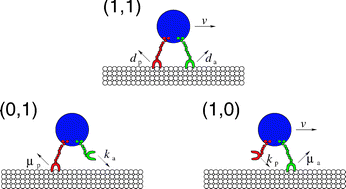Enhancement of cargo processivity by cooperating molecular motors
Abstract
Cellular cargo can be bound to cytoskeletal filaments by one or more active or passive molecular motors. Recent experiments have shown that the presence of auxiliary, nondriving motors results in an enhanced processivity of the cargo, compared to the case of a single active driving motor alone. We model the observed cooperative transport process using a stochastic model that describes the dynamics of two molecular motors, an active one that moves cargo unidirectionally along a filament track, and a passive one that acts as a tether. Analytical expressions obtained from our analysis are fit to

- This article is part of the themed collection: Physical chemistry of biomolecular motors and machines

 Please wait while we load your content...
Please wait while we load your content...